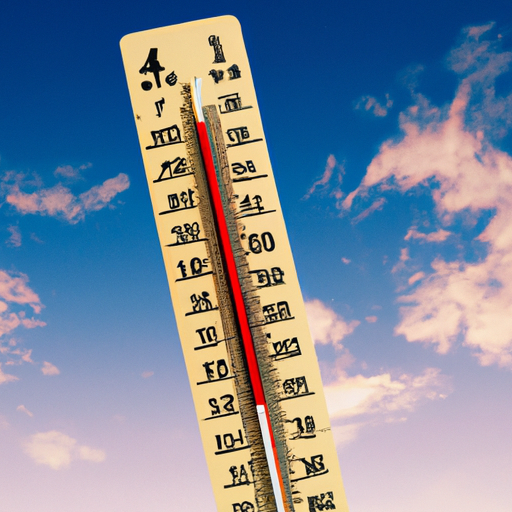With the increasing impact of climate change, doctors are urging health care providers to be more attentive to heat-related illnesses. As extreme temperatures become more frequent and intense, this poses a significant health risk to individuals across the globe. In light of this growing concern, health care professionals must prioritize preventative measures, early detection, and proactive interventions to address the heat-related challenges faced by their patients. By staying informed and taking appropriate actions, health care providers can play a crucial role in mitigating the adverse effects of heat-related illness in a changing climate.
I. Introduction
Climate change is a pressing global issue that has far-reaching effects on various aspects of society, including public health. As temperatures continue to rise and extreme weather events become more frequent, the impact of climate change on human health is becoming increasingly evident. In particular, heat-related illness is a significant health concern in the face of rising temperatures. Health care providers play a crucial role in addressing and mitigating the effects of climate change on health. This article provides a comprehensive overview of the impact of climate change on health, the importance of heat-related illness prevention, current guidelines for its management, the role of health care providers in climate change adaptation, recommendations for health care providers, case studies and success stories, potential challenges and barriers, the need for policy changes, and a conclusion that highlights the urgency of addressing climate change in the context of public health.
II. Overview of climate change and its impact on health
A. Explanation of climate change
Climate change refers to long-term shifts and alterations in weather patterns and temperature caused by human activity, particularly the emission of greenhouse gases into the atmosphere. These greenhouse gases, including carbon dioxide and methane, trap heat and contribute to the warming of the Earth’s surface. The consequences of climate change are diverse and encompass various sectors, including agriculture, infrastructure, and human health.
B. Effects of climate change on health
Climate change has a direct impact on human health, leading to various negative outcomes. Rising temperatures result in increased heatwaves and extreme heat events, posing a significant risk to public health. Heat-related illness, such as heat exhaustion and heatstroke, is a prominent concern in warmer climates. Additionally, climate change contributes to the spread of infectious diseases, air pollution, water scarcity, and mental health issues.
C. Statistics on heat-related illness
Heat-related illness is a critical health concern, particularly in regions experiencing higher temperatures and heatwaves. According to recent statistics, heat-related illnesses result in thousands of deaths globally each year. Moreover, the frequency and intensity of heatwaves are projected to increase, amplifying the risk of heat-related illnesses in the future.
III. Importance of heat-related illness prevention
A. Risks and complications of heat-related illness
Heat-related illnesses can range from mild to severe, with varying degrees of risks and complications. Mild cases may present with symptoms such as heat cramps and heat rash, while more severe cases can result in heat exhaustion or potentially life-threatening heatstroke. Immediate medical attention is necessary to prevent complications such as organ failure and death.
B. Impact on vulnerable populations
Certain groups of individuals are more vulnerable to the effects of heat-related illness. The elderly, young children, individuals with chronic medical conditions, outdoor workers, and those living in urban heat islands face an increased risk of heat-related illnesses. It is crucial to prioritize prevention efforts for these vulnerable populations to mitigate the impact of climate change on health equity.
C. Economic burden
Heat-related illness places a significant economic burden on communities and healthcare systems. The costs associated with medical treatment, hospitalizations, loss of productivity, and missed workdays due to heat-related illnesses are substantial. By investing in prevention strategies and early intervention, the economic burden can be mitigated, resulting in cost savings in the long run.
IV. Current guidelines for heat-related illness management
A. Recognizing heat-related illness
Healthcare providers must be able to recognize the signs and symptoms of heat-related illness promptly. Common indicators include excessive sweating, dizziness, nausea, headache, muscle cramps, rapid heartbeat, and confusion. Timely diagnosis is crucial for initiating appropriate management and preventing complications.
B. Initial management and first aid
Immediate first aid measures should be implemented for individuals experiencing heat-related illness. This includes moving the affected person to a cooler environment, providing water or oral rehydration solutions, removing excess clothing, and applying cool compresses. Proper first aid can significantly improve outcomes and prevent the progression of the illness.
C. Medical intervention and treatment
In severe cases of heat-related illness, medical intervention and treatment are necessary. Healthcare providers must be prepared to provide advanced care, including intravenous fluid administration, electrolyte replacement, and monitoring vital signs. Prompt medical intervention can prevent further complications and reduce mortality rates.
V. Role of health care providers in climate change adaptation
A. Awareness and education
Healthcare providers play a vital role in raising awareness about the health impacts of climate change among their patients and the wider community. By educating individuals about heat-related illness prevention, promoting adaptive behaviors, and providing information on local resources, healthcare providers can empower communities to better prepare for the effects of climate change.
B. Early detection and prevention
Healthcare providers are at the forefront of early detection and prevention efforts for heat-related illness. By identifying individuals at risk, implementing preventive measures, and conducting regular screenings, healthcare providers can effectively reduce the incidence and severity of heat-related illnesses. This includes providing guidance on hydration, appropriate clothing, and managing chronic medical conditions in the context of extreme heat.
C. Collaboration with other sectors
Addressing the health impacts of climate change requires collaboration and coordination among multiple sectors, including healthcare, public health, environmental agencies, and emergency management. Healthcare providers should actively engage in interdisciplinary partnerships to develop comprehensive strategies for climate change adaptation. Collaboration can facilitate the exchange of knowledge, resources, and best practices, resulting in more effective approaches to climate change mitigation.
VI. Recommendations for health care providers
A. Updated protocols and guidelines
Healthcare providers should advocate for the development and dissemination of updated protocols and guidelines for the management of heat-related illness. These guidelines should reflect the latest scientific evidence, best practices, and local context. By adhering to evidence-based protocols, healthcare providers can ensure standardized and high-quality care for individuals affected by heat-related illness.
B. Training and education
Continuous training and education for healthcare providers are essential to enhance their knowledge and skills in addressing heat-related illness in the context of climate change. Training programs should cover topics such as early recognition, first aid measures, advanced medical intervention, and collaborative approaches to climate change adaptation. By investing in professional development, healthcare providers can deliver optimal care and support to their patients.
C. Increased surveillance and data collection
Robust surveillance and data collection systems are necessary to monitor the prevalence, incidence, and outcomes of heat-related illness. Healthcare providers should actively contribute to these efforts by reporting cases, sharing data, and participating in research studies. The collection and analysis of data can inform evidence-based decision-making, guide mitigation strategies, and monitor the effectiveness of heat-related illness prevention programs.
VII. Case studies and success stories
A. Implementation of heat-related illness prevention programs
Numerous successful initiatives have been implemented worldwide to prevent heat-related illness. These programs often involve collaborations between healthcare providers, public health agencies, community organizations, and local governments. Examples include the distribution of cooling kits to vulnerable populations, the establishment of cooling centers during heatwaves, and public health campaigns promoting heat safety measures.
B. Impact on patient outcomes
The implementation of heat-related illness prevention programs has demonstrated positive impacts on patient outcomes. Studies have shown a reduction in the incidence of heat-related illnesses, hospitalizations, and mortality rates in communities with effective prevention strategies. These findings highlight the importance of investing in preventive measures and early intervention to improve patient outcomes and overall public health.
C. Lessons learned
Case studies and success stories provide valuable lessons for healthcare providers and policymakers. Key takeaways include the importance of interdisciplinary collaboration, community engagement, targeted interventions for vulnerable populations, and sustained investments in climate change adaptation. By learning from successful initiatives, healthcare providers can optimize their approach to addressing heat-related illness in the context of climate change.
VIII. Potential challenges and barriers
A. Limited resources and funding
One of the major challenges in addressing heat-related illness prevention is the limited availability of resources and funding. Healthcare systems are often strained, and implementing comprehensive prevention programs may require additional financial support. Healthcare providers must advocate for increased funding, resource allocation, and infrastructure development to ensure the effective implementation of preventive measures.
B. Lack of awareness and prioritization
Despite the significant health impacts of climate change, there is still a lack of awareness and prioritization among policymakers, healthcare providers, and the general public. Addressing this challenge requires comprehensive awareness campaigns, educational initiatives, and advocacy efforts. Healthcare providers should actively engage in public discourse and collaborate with stakeholders to foster a greater understanding of the urgency and importance of heat-related illness prevention.
C. Resistance to change
Resistance to change can hinder the implementation of effective heat-related illness prevention strategies. Healthcare providers may encounter resistance from within their institutions or communities due to various factors, including inertia, skepticism, or competing priorities. Overcoming resistance requires effective communication, engagement, and evidence-based advocacy to demonstrate the value and necessity of climate change adaptation in healthcare settings.
IX. The need for policy changes
A. Government support and initiatives
Policy changes at the government level are necessary to address the health impacts of climate change effectively. Governments should demonstrate leadership by incorporating climate change adaptation into public health policies, allocating resources for prevention programs, and integrating climate change considerations into healthcare infrastructure planning. Government support and initiatives are crucial to catalyze the scale-up of heat-related illness prevention efforts.
B. Integration of climate change in healthcare policies
Healthcare policies should explicitly address the impact of climate change on health and include specific measures for heat-related illness prevention. This integration can include requirements for healthcare providers to receive training on climate change adaptation, the establishment of heat emergency response plans, and the inclusion of climate change considerations in healthcare facility standards. By integrating climate change in healthcare policies, healthcare providers are better equipped to address the health risks associated with rising temperatures.
C. Advocacy and public awareness
Healthcare providers have a unique position to advocate for policy changes and raise public awareness about the health impacts of climate change. By engaging in advocacy efforts, healthcare providers can promote the adoption of evidence-based policies, secure funding for prevention programs, and influence public opinion. Advocacy and public awareness campaigns are essential to drive meaningful policy changes and ensure the prioritization of heat-related illness prevention in broader climate change adaptation strategies.
X. Conclusion
The impact of climate change on health, particularly in the context of heat-related illness, is a significant concern that requires urgent attention from healthcare providers. By recognizing the risks and complications of heat-related illness, healthcare providers can play a critical role in prevention, early detection, and treatment. The adoption of updated protocols, continuous training and education, and increased surveillance and data collection are necessary to optimize healthcare providers’ response to heat-related illness. Collaboration with other sectors, lessons from successful initiatives, and addressing potential challenges and barriers are key components of effective climate change adaptation. Government support, policy changes, and advocacy efforts are essential to address the health impacts of climate change comprehensively. Through collective action and a focused approach, healthcare providers can contribute to mitigating the effects of climate change on health and ensuring the well-being of communities worldwide.








